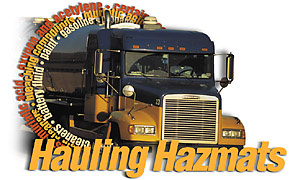
The transportation of hazardous materials is serious business. So much so, most companies won’t touch it. For some, transporting hazmat is a necessary evil — regulations to be reluctantly embraced and wrestled with, just to get a job done that has nothing to do with hazmat transportation.
Does transporting a hazardous material to a job site or work area always have to be such a headache?
Absolutely not. Companies are finding relief from the never-ending nightmare of complying with the Hazardous Materials Regulations (HMR) with three simple words: materials of trade.
Unaware of exceptions
The materials of trade exceptions are nothing new. 49 CFR 173.6 has been in the HMR for some time. What’s surprising is the number of companies unaware that the exceptions allow the transportation of hazardous materials without being subject to the requirements of the HMR.“Not subject to any other requirements of this subchapter†is a phrase seldom found in the HMR. It is one that quickens the pulse of anyone who has ever had to spend time poring over paragraph after paragraph and page after page of hazmat regulations.
To clarify, the phrase means not having to comply with the requirements of Subchapter C of 49 CFR. That’s not everything as far as the regulations are concerned, but it’s close. The majority of what needs to be done, compliance-wise, when transporting a hazardous material, is found in that subchapter.
You’ll find the very same phrase in the first paragraph of 49 CFR 173.6. If you follow the provisions contained within that one specific section, you’re good to go when transporting smaller amounts of certain hazardous materials.
It’s like having a “Get Out Of Jail Free†card when transporting hazmat.
There has to be a catch somewhere. Right?
Not really. The materials of trade exceptions aren’t going to help companies that ship or transport large amounts of hazmat day in and day out. They are not designed for those who make their living shipping or hauling hazmat. However, the exceptions can help many companies that aren’t typical hazmat haulers.
What’s the purpose?
Materials of trade are hazardous materials carried on a motor vehicle for at least one of the following:
The bottom line is certain hazardous materials transported in smaller quantities do not present the hazards in transportation associated with hazmat transportation in general.
Fine print
There are restrictions — let’s call it “fine print†— on what can be transported and how much. A material of trade is limited to the following types of hazardous materials:
- Division 2.1 (flammable gases) and Division 2.2 (non-flammable gases);
- Class 3 (flammable or combustible liquids);
- Division 4.1 (flammable solids) and Division 4.3 (spontaneously combustible materials);
- Division 5.1 (oxidizers) and Division 5.2 (organic peroxides);
- Division 6.1 (poisons);
- Class 8 (corrosives);
- Class 9 (miscellaneous hazmat);
- ORM-D (consumer commodities).
Each hazmat must be either packaged in the manufacturer’s original package or one of equal strength. Packages have to be leak-tight for liquids and gases, and sift-proof for solids. They must be securely closed, secured against shifting and protected against damage.
If the hazmat is a high hazard (Packing Group I), the maximum amount allowed in one package is one pound or one pint. In most cases, a hazmat package with medium or lower hazards (Packing Group II or III) may contain a maximum amount of 66 pounds or eight gallons.
Cylinders containing a Division 2.1 or 2.2 gas may not weigh more than 220 pounds each. There are no package limits for ORM-D (consumer commodities), which account for a large share of the hazmat transported by contractors, builders, plumbers, welders and so on.
Except for tanks containing diluted mixtures of a Class 9 material, the maximum limit is 440 pounds on any motor vehicle. If you need to transport more than that, why not make two trips or take two vehicles? It makes good sense. Why get involved with the hazmat regulations when it isn’t necessary?
A hard look
Take a hard look at 49 CFR 173.6. Determine if it will work for you. Be certain anyone transporting hazmat under the materials of trade exceptions knows the materials are hazardous and knows about 49 CFR 173.6.
Make a copy of that particular section (about a page) and carry it in the vehicle transporting the hazmat. It never hurts to have a “Get Out Of Jail Free†card along, just in case.
SIDEBAR: Examples of MOTs
- paint and paint thinner
- gasoline
- diesel fuel
- engine starting fluid
- battery fluid
- drain cleaners
- bleaching compounds
- muriatic acid
- propane
- oxygen and acetylene
- certain pesticides
